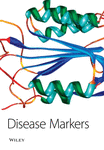Fetal Growth, Gestation Length And Phosphoglucomutase-1 Phenotype
Abstract
This study investigates reports that phosphoglucomutase-1 (PGM1) phenotype is associated with fetal growth and gestation length. A total of 350 women were studied, 234 having uncomplicated pregnancies and 114 with a baby weighing greater than 90th centile, corrected for parity, gestation and fetal sex. All women had gestation confirmed by early ultrasound. Conventional cellulose acetate electrophoresis was used to distinguish the three common PGM1 phenotypes and polyacrylamide gel isoelectric focusing to distinguish the ten PGM1 SUbtypes. Neither PGM I phenotype nor SUbtype were found to be associated with gestation length or standardised birth weight. Logistic regression, where maternal age, parity, fetal sex, maternal weight, gestation and smoking were introduced as explanatory variables in addition to PGM1 phenotype testing against the dependent variables birth weight, standardised birth weight and gestation length, did not show differences related to PGM1 phenotype.
Two possible reasons for the discrepancy with previously published data are discussed. We conclude that the study provides no support for the belief that PGM1 phenotype is related to fetal growth or gestation length and that the original observations could have arisen as a result of statistical artefact due to multiple testing.




